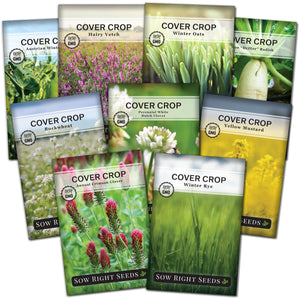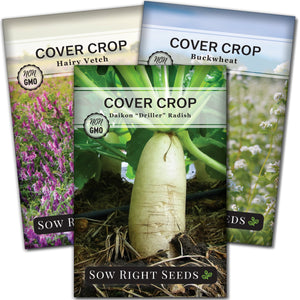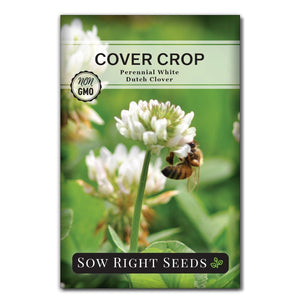Why Your Garden Needs Austrian Winter Peas as a Cover Crop
Cover crop growing tipsAustrian Winter Pea, also known as field pea, is an easy-to-grow legume that is closely related to English peas but is usually grown as ground cover. Austrian Winter Pea is increasing in popularity as a cool season cover crop and is a good choice for gardeners who want something to cover a garden allotment or raised beds during the off-season. This versatile cover crop can be sown in fall to overwinter or in early spring in cool climates.

Why Your Garden Needs Austrian Winter Peas as a Cover Crop
Why should you grow Austrian Winter Pea in your garden? Let’s look at a few of the benefits it provides.
Nutrient-Rich
Like all legumes, Austrian Winter Pea is known for its exceptional ability to fix nitrogen from the atmosphere and transfer it to the soil, where other plants can readily access it. When it is later cut down and incorporated into the soil as green manure, it also provides a substantial amount of organic matter and helps create a nutrient-rich environment ideal for later crops. This reduces the need for fertilizer and improves the productivity of your garden.
Cold Resistance
Unlike many other cover crops, Austrian Winter Pea is incredibly cold-tolerant, frequently surviving temperatures as low as 0-10°F for short periods without protection. This means it can often overwinter in USDA zones 6 and warmer (barring extreme weather events or sudden temperature drops). For even better tolerance in colder zones, interplant them with winter rye, which will shelter the pea plants from wind and cold.
Weed Control
Austrian Winter Pea is an excellent weed suppressor. Its rapid growth and dense foliage effectively outcompete weeds that would otherwise overcome your fallow plots. Once it's time to cut down the peas, the plant residue forms a mulch barrier that will break down into organic matter and continues to prevent weeds from invading. You’ll be able to maintain a neat, healthy garden in the off-season.
Soil Improvement
Austrian Winter Peas have a deep root system that helps break up compacted soil, prevent crusting, and improve soil structure. The root system prevents soil erosion by holding the soil in place and reducing runoff while also improving water infiltration and balancing soil moisture levels.
Flowers for Pollinators
If allowed to fully flower, Austrian Winter Pea has lovely purple and pink bicolored flowers that are a magnet for beneficial insects. Its graceful vines and lovely blooms are highly ornamental. In spring, they can attract bees, butterflies, and other pollinators, improving the overall health of your garden ecosystem.

Edible & Delicious
The flowers, shoots, and leaves of Austrian Winter Peas are sweet, with a flavor similar to sugar snap peas. You can harvest the young tender greens as a winter green (mature leaves can be tough and stringy). They’re highly nutritious and are delicious in salads. If you allow pods to develop, they are also good to eat but are not quite as sweet as most peas. Fully mature Austrian Winter Peas make an excellent dried soup pea, as well.
Austrian Winter Peas for Deer
Deer, livestock, and other animals also enjoy eating Austrian Winter Peas. Planting a patch of Austrian Winter Peas can provide a dependable food source for grazing throughout the fall and winter. If you're a hunter, planting Austrian Winter Peas can also help attract deer.

How to Grow and Use Austrian Winter Pea as a Cover Crop
Growing Austrian Winter Pea is relatively easy, and the plants are low maintenance. Broadcast the seeds in your garden in late summer, early fall, or early spring. Water the area and rake the seeds lightly into the soil. Austrian Winter Peas prefer well-drained soils, as waterlogged conditions can be detrimental.
For the best soil enrichment and to prevent reseeding, you should mow or cut down the plants in the spring at the early bloom stage but before they produce pods. If they're allowed to fully flower and go to seed, they'll redirect nitrogen from the plant body to seed production instead of into the soil. You can “chop and drop” - allowing the plant debris to stay on the surface as mulch and decompose naturally, or till them into the soil to release their stored nutrients.
Austrian Winter Pea is an excellent addition to any garden. If you plant this versatile cover crop, you'll enjoy a more fertile, healthier garden, with the added benefit of a lovely floral display that delights pollinators.
Plant Austrian Winter Pea as a cover crop in your garden this year, and you'll be reaping the benefits for seasons to come.
Written by Theresa Chandler
Found this information helpful? Share it with your gardening friends!










Dorothee – Thank you so much for catching our error! We had planted a mixture of cover crops. We’ve updated our pictures with just Austrian Winter Pea.
You have a lovely picture, but it doesn’t look like Austrian winter peas.
I believe the foreground in vetch, and a type of crimson clover flowering in the background d
Leave a comment